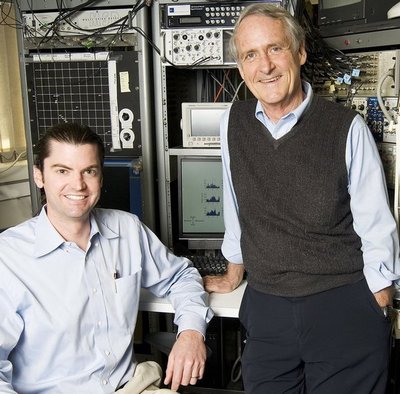October 15, 2008
Brain nerve cells can directly control stimulation of paralyzed muscles through an artificial connection
An artificial connection between nerve cells in the brain and muscles has been shown to restore voluntary movement to paralyzed limbs. This finding was reported today in the journal Nature.
Scientists would like to discover how to re-route brain signals to bypass damaged nerves to treat spinal cord injuries. A spinal cord injury impairs nerve pathways, but spares muscles and brain tissue.
Unlike previous experiments to activate paralyzed muscles through pre-determined electrical stimulation, or to tap brain activity to operate robotic arms or computer cursers, in this study muscles were directly stimulated using the activity of neurons in the motor cortex, the part of the brain that normally controls limb movement.
The study was proof of concept: it showed that the idea could work. What was exciting about this direct stimulation, said Dr. Eberhard Fetz, University of Washington professor of physiology & biophysics and a researcher at the Washington National Primate Research Center at the UW, is that it avoids the complex process of decoding neural signals to control a computer or robotic device. Direct stimulation of muscles may allow individuals to have more natural control of movement through their own volition. The experiments were performed with laboratory instrumentation, but the researchers also built a portable electronics device from off-the-shelf components to convert signals from the motor cortex neuron cells into stimuli. The device would fit in a matchbox and runs on AA batteries and would allow long-term practice with the artificial connection.
The research was conducted at the Washington National Primate Center and supported by the National Institutes of Health (NIH) Neurology Institute. Monkeys learned to use direct, artificial stimulation from arbitrarily chosen motor cortex cells, delivered to multiple muscles, to flex and extend their wrist to play a video game. Their wrist nerves had been temporarily numbed with a local anesthetic like lidocaine, which paralyzed the muscles. Despite the nerve block, the monkeys were able to control the contraction strength of their wrist muscles to match a set of targets on a computer screen. Controlling the degree of muscle contraction is what allows us to pick up an egg without breaking the shell or to grab tightly to a handrail to avoid a fall.
The monkeys got better at the video game with practice as they learned to control the neurons that triggered muscle stimulation. This method of learning to control a computer cursor is comparable to biofeedback training to moderate hand temperature or heart rate.
The scientists also found that neurons unrelated to wrist movement could provide signals to move wrist muscles. Moreover, muscles that flex and extend the wrist could be activated separately from different neurons.
“Nearly every motor cortex neuron we tested in the brain could be used to control the stimulation of the wrist muscles,” said Dr. Chet Moritz, UW senior fellow in physiology and biophysics and lead author on the study, which also included UW researcher Steve Perlmutter. In particular, even brain cells initially unrelated to movement could be controlled and used to stimulate muscles.
“With biofeedback the brain can rapidly learn to control new cells to generate movement,” Fetz noted. Because of this, perhaps someday researchers may help stroke patients by using stimulation from undamaged brain areas to restore function lost from damage in other areas of the brain.
The researchers think about a decade more of research is necessary before direct stimulation of muscles from brain cells can be applied in patients. The current study was limited by the temporary nature of the nerve block and the small range of neurons and muscles studied. Further development of a similar device might be useful in allowing severely paralyzed individuals to turn dials, press buttons, or hold a coffee cup.
To improve the practicality of this approach to treating paralysis with artificial nerve connections, scientists would need to increase the number of control signals from the brain to manage more muscle groups. At present researchers are hoping to scale up the device to a greater number of neurons. They might also try to find ways to control coordinated patterns of muscle activity by stimulating the spinal cord. Among other aspects that would need to be addressed before neural control of nerve or spinal stimulation becomes applicable and acceptable for patient testing are the size of the device, which needs more miniaturization, the wiring, and the power source.
“We could look into the possibilities of other power sources such as radiofrequency transmission,” said Fetz. The miniaturization problem is also being addressed: scientists in UW Biology and Electrical Engineering Departments have already created chips small enough to place on a large insect.
Researchers would also have to determine the best placement for the recording electrodes. Using signals recorded from outside the skull would be less invasive but would provide less information, whereas neural signals recorded from electrodes inside the brain provide more information, but such recording is limited by eventual loss of signal due to cells growing on the electrodes.
Overall, the scientists observed, showing that brain nerve cells unrelated to movement can be recruited into movement control is another example of the striking plasticity of the brain.
“The brain can modify the activity of its cells beyond the conventional ways of characterizing their activity,” they said. “We still don’t know how flexible the brain is in reassigning cells to different functions.”

